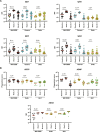Waning immunity and IgG4 responses following bivalent mRNA boosting
- PMID: 38394195
- PMCID: PMC10889350
- DOI: 10.1126/sciadv.adj9945
Waning immunity and IgG4 responses following bivalent mRNA boosting
Abstract
Messenger RNA (mRNA) vaccines were highly effective against the ancestral SARS-CoV-2 strain, but the efficacy of bivalent mRNA boosters against XBB variants was substantially lower. Here, we show limited durability of neutralizing antibody (NAb) responses against XBB variants and isotype switching to immunoglobulin G4 (IgG4) responses following bivalent mRNA boosting. Bivalent mRNA boosting elicited modest XBB.1-, XBB.1.5-, and XBB.1.16-specific NAbs that waned rapidly within 3 months. In contrast, bivalent mRNA boosting induced more robust and sustained NAbs against the ancestral WA1/2020 strain, suggesting immune imprinting. Following bivalent mRNA boosting, serum antibody responses were primarily IgG2 and IgG4 responses with poor Fc functional activity. In contrast, a third monovalent mRNA immunization boosted all isotypes including IgG1 and IgG3 with robust Fc functional activity. These data show substantial immune imprinting for the ancestral spike and isotype switching to IgG4 responses following bivalent mRNA boosting, with important implications for future booster designs and boosting strategies.
Figures





References
-
- Polack F. P., Thomas S. J., Kitchin N., Absalon J., Gurtman A., Lockhart S., Perez J. L., Pérez Marc G., Moreira E. D., Zerbini C., Bailey R., Swanson K. A., Roychoudhury S., Koury K., Li P., Kalina W. V., Cooper D., Frenck R. W. Jr., Hammitt L. L., Türeci Ö., Nell H., Schaefer A., Ünal S., Tresnan D. B., Mather S., Dormitzer P. R., Şahin U., Jansen K. U., Gruber W. C., C4591001 Clinical Trial Group , Safety and efficacy of the BNT162b2 mRNA Covid-19 vaccine. N. Engl. J. Med. 383, 2603–2615 (2020). - PMC - PubMed
-
- Baden L. R., el Sahly H. M., Essink B., Kotloff K., Frey S., Novak R., Diemert D., Spector S. A., Rouphael N., Creech C. B., McGettigan J., Khetan S., Segall N., Solis J., Brosz A., Fierro C., Schwartz H., Neuzil K., Corey L., Gilbert P., Janes H., Follmann D., Marovich M., Mascola J., Polakowski L., Ledgerwood J., Graham B. S., Bennett H., Pajon R., Knightly C., Leav B., Deng W., Zhou H., Han S., Ivarsson M., Miller J., Zaks T., COVE Study Group , Efficacy and safety of the mRNA-1273 SARS-CoV-2 vaccine. N. Engl. J. Med. 384, 403–416 (2021). - PMC - PubMed
-
- Sadoff J., Gray G., Vandebosch A., Cárdenas V., Shukarev G., Grinsztejn B., Goepfert P. A., Truyers C., Fennema H., Spiessens B., Offergeld K., Scheper G., Taylor K. L., Robb M. L., Treanor J., Barouch D. H., Stoddard J., Ryser M. F., Marovich M. A., Neuzil K. M., Corey L., Cauwenberghs N., Tanner T., Hardt K., Ruiz-Guiñazú J., le Gars M., Schuitemaker H., van Hoof J., Struyf F., Douoguih M., ENSEMBLE Study Group , Safety and efficacy of single-dose Ad26.COV2.S vaccine against Covid-19. N. Engl. J. Med. 384, 2187–2201 (2021). - PMC - PubMed
-
- Naranbhai V., Garcia-Beltran W. F., Chang C. C., Berrios Mairena C., Thierauf J. C., Kirkpatrick G., Onozato M. L., Cheng J., St Denis K. J., Lam E. C., Kaseke C., Tano-Menka R., Yang D., Pavlovic M., Yang W., Kui A., Miller T. E., Astudillo M. G., Cahill J. E., Dighe A. S., Gregory D. J., Poznansky M. C., Gaiha G. D., Balazs A. B., Iafrate A. J., Comparative immunogenicity and effectiveness of mRNA-1273, BNT162b2, and Ad26.COV2.S COVID-19 vaccines. J. Infect. Dis. 225, 1141–1150 (2022). - PMC - PubMed
-
- Davis-Gardner M. E., Lai L., Wali B., Samaha H., Solis D., Lee M., Porter-Morrison A., Hentenaar I. T., Yamamoto F., Godbole S., Liu Y., Douek D. C., Lee F. E.-H., Rouphael N., Moreno A., Pinsky B. A., Suthar M. S., Neutralization against BA.2.75.2, BQ.1.1, and XBB from mRNA bivalent booster. N. Engl. J. Med. 388, 183–185 (2023). - PMC - PubMed
Publication types
MeSH terms
Substances
Grants and funding
LinkOut - more resources
Full Text Sources
Miscellaneous

